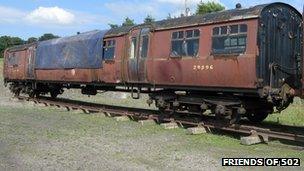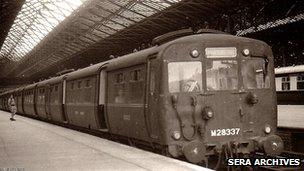502 train Merseyrail set for new life
- Published

The group say the full restoration is expected to take "a few years"
A rotting train - which was once at the cutting edge of rail travel - is to be given a new lease of life by enthusiasts.
The LMS-designed Class 502 Electric Multiple Unit (EMU) was the most advanced of its time when it started life in the forties on the suburban lines around Liverpool.
Replacing the existing steam-hauled carriages, they had significant improvements - automatic sliding doors, higher speeds and increased frequency.
This last remaining 502 was saved from the scrapyard in 1980, after running its final service on Merseyrail.
In 2009, the Friends of the 502 group acquired it from the National Railway Museum when they found out there was no room to store it.
The group said it was a "shame to see it go to scrap" so they took it over and stored it at a site in Tebay, Cumbria.
They now hope to restore it to "almost original condition".
Peeled paint
Currently residing on the side of the M6, with broken windows and peeled paint, it will move to a new home in Burscough, Lancashire, where it is to be restored.
Duncan Reed, from Friends of the 502, said: "We are hoping to bring it back to a state where we can run it on the Merseyrail network actually hauling passengers.
"It will take a while and quite a few thousand pounds, but if we aim high, then that's the way to go."

A 502 stands at Southport Chapel Street, Merseyside
After 40 years of service, the 502 was moved to a new route on the Merseyrail, which took its toll on the electric vehicle.
The steep gradients on the line and increased use proved too difficult for the train and it was withdrawn from service on 1 September 1980.
However, one of the units was preserved in case it could run again in the future, and it went on display at Steamport railway centre in Southport.
In 1997 when the museum closed, the train then moved to Kineton where it was stored outside.
It was this time spent outside that led to its deterioration through corrosion.
Mr Reed said: "I think it is not just part of Merseyside's history, but also, it's the forerunner of modern train design so it seems like an important unit historically.
"We're hoping to get it restored to almost original condition."
Large sections of its bodywork will be replaced, together with a full re-wire, refurbishment of all the interior woodwork and seats and work on the wheels, bogies and traction motors.
The group say the full restoration is expected to take "a few years".
- Published13 January 2012